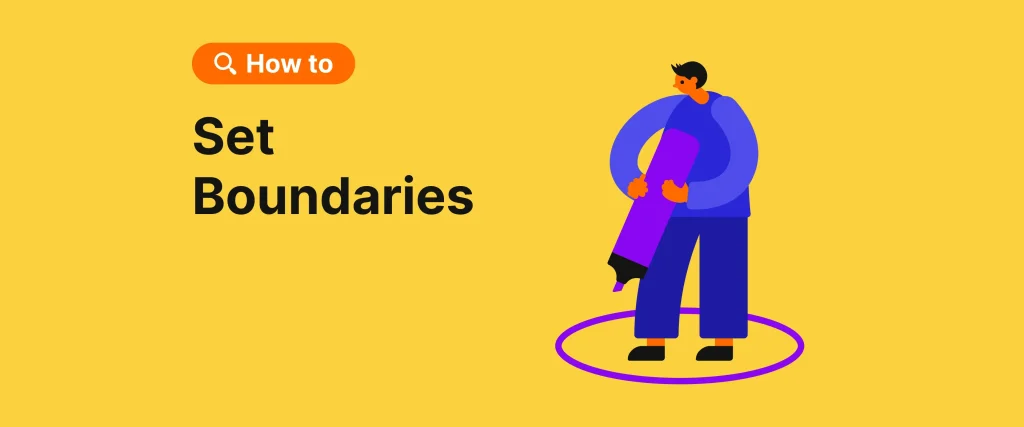How to set healthy boundaries

Setting healthy boundaries is an essential skill for maintaining emotional well-being, fostering healthy relationships, and promoting personal growth. Boundaries define where one person ends and another begins—they help us protect our values, manage stress, and communicate our needs clearly. Without boundaries, people often feel overwhelmed, drained, or taken advantage of. Learning to set and maintain boundaries is a vital part of self-care and self-respect.
Understanding Boundaries

Boundaries are the invisible lines that define our personal limits in relationships, work, and life in general. They come in various forms: emotional, physical, mental, and even digital. Emotional boundaries protect your feelings, helping you avoid absorbing others’ stress or negativity. Physical boundaries relate to your personal space and touch, while mental boundaries involve protecting your thoughts, beliefs, and opinions. Digital boundaries, increasingly relevant today, involve limiting access to your time and attention through social media, messaging apps, and emails. Recognizing the types of boundaries you need is the first step toward setting them effectively.
The Importance of Boundaries
Healthy boundaries have numerous benefits. They reduce stress and prevent burnout by helping you say no when necessary. They foster respect in relationships by clearly communicating your limits. Boundaries also empower you to prioritize your needs, promote self-confidence, and improve overall mental health. People with well-established boundaries tend to experience more fulfilling and balanced relationships, as they interact with others from a place of clarity rather than obligation or guilt.
Signs You Need Boundaries
It’s important to identify when boundaries are lacking. Common signs include:
- Feeling resentful or angry after helping others
- Constantly putting others’ needs above your own
- Feeling drained or overwhelmed by relationships
- Struggling to say no, even when you want to
- Feeling guilty for taking time for yourself
Recognizing these signs is crucial because they indicate that your personal limits are being tested or ignored, and it’s time to take action.
Steps to Set Healthy Boundaries

1. Reflect on Your Needs and Values
Start by understanding what is important to you. Reflect on your emotional, physical, and mental limits. Ask yourself: What drains my energy? What makes me uncomfortable? What am I unwilling to compromise on? Clarifying your needs will help you set boundaries that protect your well-being.
2. Communicate Clearly and Assertively
Boundaries are only effective if they are communicated clearly. Use “I” statements to express your needs without blaming others. For example, say, “I feel overwhelmed when I receive work messages after 7 PM. I need to disconnect during personal time.” Assertive communication helps others understand your limits without creating unnecessary conflict.
3. Learn to Say No
Saying no is an essential skill in boundary setting. It’s not selfish—it’s a way to honor your time, energy, and values. Start small by declining requests that you genuinely cannot accommodate, and gradually work your way up to more significant situations. Remember, every time you say yes to something that drains you, you’re saying no to something that truly matters.
4. Practice Self-Care
Setting boundaries is closely tied to self-care. Prioritize activities that rejuvenate you—whether it’s reading, exercising, meditating, or spending time with loved ones. When you care for yourself, maintaining boundaries becomes easier because you recognize the importance of protecting your well-being.
5. Prepare for Resistance
Some people may resist or challenge your boundaries, especially if they are used to taking advantage of your time or energy. Stay firm and consistent. Boundaries are about respect, not confrontation. Over time, most people will learn to honor your limits once they see that you are serious about them.
6. Reassess and Adjust
Boundaries are not static. Your needs may change over time, so regularly reassess your limits. Be flexible, but never compromise on values that are essential to your mental or physical health.
Conclusion
Setting healthy boundaries is a journey of self-awareness, communication, and self-respect. While it can be challenging at first, the long-term benefits are undeniable. Boundaries reduce stress, enhance relationships, and empower you to lead a more balanced and fulfilling life. By reflecting on your needs, communicating assertively, practicing self-care, and staying consistent, you can create a life that honors your limits and promotes well-being. Remember, boundaries are not walls—they are bridges to healthier connections with yourself and others.
